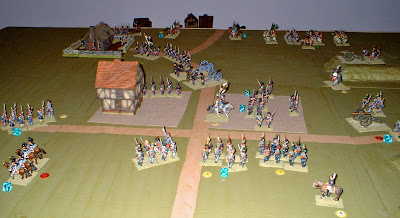
We have now done about 6 or 7 weeks of the
PBEM 1806 Campaign, and the long awaited battle is still awaited. I was really sure last week that we were about to cross swords with the Prussians around Jena, but they have disappeared.
I have had quite a bit of success with the Game Master, who has finally let me have an order of battle for the Prussian army, give or take 10% and six days old. But at least I have some idea what I am up against.
We are using the umpire map, which is quite
adequate when we were many days march apart. But now that we are within 10 miles of each other you need a lot more details, and that is not
available. So there are constant questions about woods, hills, bridges and fords. I have just checked the email folder for mails to and from the umpire, and there were nine pages.
As
Napolelon I get a weekly situation map, which is a daily situation map in campaign terms, which shows the locations of my formations and any identified enemy. This map, and subsequent questions, take up
about 8 of
those 9 pages of emails. I had finally got confirmation that there was a large body of Prussians, about 4 infantry divisions and perhaps 3 or 4 cavalry brigades. All of last week was spent planning some very clever moves on my pretty inadequate map. I was convinced that we would have a battle today/this week, and told my wing commanders so. They advanced to recce the field, only to discover that the Prussian horde had disappeared!
Its very interesting to compare this
PBEM campaign with my own 1813 campaign. The latter is designed to produce good
wargames with the minimum of paperwork. So there is no element of fog of war at all. Its a bit like playing a board game, where I (as umpire) can see everyone
everywhere.
The
PBEM on the other hand is the exact opposite. I know fairly well where my corps and divisions are, though they sometimes do not arrive exactly where I have told them to be. But no idea at all about the enemy, and even when I do find them they often just disappear.
Then there is the map problem. Although I have the map on the computer, and it is updated each week/day, it is very difficult to plot moves over the coming day. I have done a hand drawn map to plan moves with markers. But I can not put them on the computer. I am sure that there must be a way to do it, but I need a modern day
Berthier to help me do so.
So which is the most fun? Really hard to say, as they are so different. But I certainly spend a lot more time working on the
PBEM campaign, and look forward to getting the next report from a cavalry patrol or the daily update from
Berthier with the situation map. On the other hand is it very frustrating having to wait days or even weeks (real time) for a plan to develop. There has been no problem maintaining my interest for far, but it must be more difficult for the wing commander who can only move where I tell them and will not really come into their own until a battle is fought - if it ever is.
So it will be a couple of weeks before I can report any great developments. Meanwhile I will continue to struggle with the fog of war, which gets thicker and thicker with each email I receive.







+rout+from+town.JPG)










